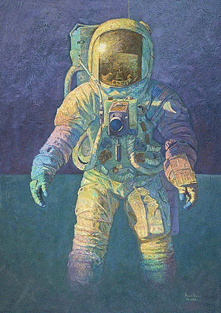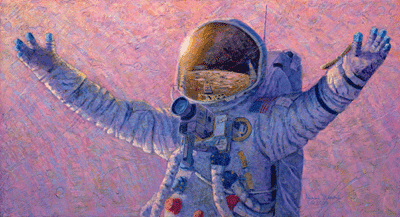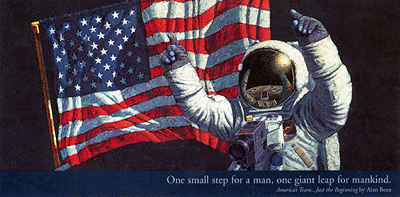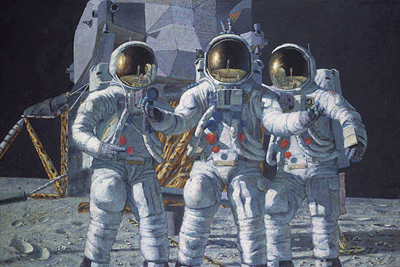Moon Walkers
Air Date: Week of September 23, 2005

"That's What It Felt Like to Walk on the Moon" (Alan Bean, © The Greenwich Workshop, Inc.)
As NASA considers a manned mission to the moon in the next few decades, Living on Earth takes a look back at the twelve men who lay claim to the title "Moonwalker." Host Bruce Gellerman talks with author Andrew Smith about his new book, "Moondust: In Search of the Men Who Fell to Earth." Also, astronaut Alan Bean, the fourth man to walk on the moon, talks about his life after returning to Earth, and the artwork that keeps his lunar memories alive.
Transcript
GELLERMAN: Sending a man to the moon is a trophy that America has proudly displayed on the nation’s mantle since 1969 when Neil Armstrong took one small step and became the first man to walk on the moon. That trophy has gathered more than a little dust since the age of the Apollo Project, no one’s been back to the moon in over 33 years.
But now, NASA plans to jump-start its lunar project, and promises to send a man back to the moon by 2018. Only a dozen men have been to the moon, and of those twelve, only nine survive. Writer Andrew Smith wondered what became of those men who shared that extraordinary experience. His new book is called “Moondust: In Search of the Men Who Fell to Earth.” He joins me now. Andrew, hello. SMITH: Hi, nice to be here. GELLERMAN: I want you to clear up something for me right away. Listen to the quote by Armstrong and you tell me what he’s saying. RECORDING OF ARMSTRONG: That’s one small step for man, one giant leap for mankind. GELLERMAN: It’s a little garbled there, but does he say “one small step for man” or “a man”? SMITH: Well, to me it sounds like “man”, but he insisted for years that he said “a man.” But I think it’s fairly clear from that that he left out the “a.” GELLERMAN: Did he come up with that himself? In the book you suggest it might not have been the case. SMITH: Well, one thing we do know, I think, is that NASA didn’t tell him what to say. Because the commander of the second mission, Apollo 12, which landed later in that year, 1969, he had an Italian journalist friend who just didn’t believe that Neil Armstrong had been allowed to make up the words himself. So Pete Conrad, who was a very colorful character, this commander, he bet her 500 dollars that he could nominate the words he was going to say there and then, which he did. And he was a diminutive guy, Pete Conrad, so, sure enough, when he stepped off the ladder all the viewers and listeners heard him say, “Whoopie, that may have been a small step for Neil, but it was a big one for me!” GELLERMAN: (Laughs) SMITH: So I think, yeah, I think Armstrong probably did make it up. GELLERMAN: You spoke to all of the nine surviving moonlanders. SMITH: I spoke to all of them. Seven of them sat down for proper interviews and sort of lengthy chats, yeah. GELLERMAN: They were all very strange men, the way I read your book. SMITH: Yes, and I was going to say, one of the big surprises for me was what a diverse group of individuals they are. Because I’d expected that they would be fairly buttoned down, straight arrow sort of guys, and, in actual fact, they ranged right across the spectrum. For instance, Edgar Mitchell, who was on the third mission to land, had what he called an epiphany on the way back from the moon and felt as though there was a consciousness around him in the universe. And he felt plugged into it and came back and quit NASA and founded a New Age organization. Another quit NASA, Alan Bean, quit NASA and became a painter afterwards. And he now endlessly paints scenes from the moon landings in oils, and he’s very, very successful at it. Another one felt he heard God talking to him on the surface of the moon. He came and quit when he got back and founded a ministry. So they really are a diverse bunch of people. GELLERMAN: You don’t paint a very good picture of Buzz Aldrin, actually. He’s very competitive, and you say that when he was on the moon he only takes one picture of Armstrong, and that’s a picture of him being reflected in Armstrong’s visor. SMITH: Yes, that’s right. Michael Collins, who flew with him, who was the command module pilot, which means he was the one who stayed in the command module circling the moon and didn’t land, he has said that Buzz took more umbrage with not being the first on the moon than he got joy from being the second. And he suffered a lot when he got back. He suffered from depression and alcoholism which wasn’t spotted for a long time. And don’t forget that these guys weren’t well paid. Those who were military were paid according to their military rank. At that time, that wasn’t a great deal of money. And there was no danger money or anything like that. So I think Buzz, he’s had a hard time. I mean, I can empathize with him a great deal, I think. GELLERMAN: Yeah, there’s a real sadness in the book. You write about one of the astronauts selling his autograph in Las Vegas for 10 dollars a pop. SMITH: Well, yeah, his name was Dick Gordon. He was the command module pilot on Apollo 12, the second mission. And the funny thing is that, as far as all the memorabilia goes and the Apollo nuts and the celebrity aspect of the whole thing, as one collector explained to me, the command module pilots market value is much lower than any of the others. So they can’t sell their autographs at 500 dollars a time the way Buzz does. So I actually found him, yeah, at a Star Trek convention in Las Vegas, sitting at a table on his own signing autographs for 20 dollars a time, surrounded by all these other actors. And there were big lines at the other tables, people waiting to have their autographs signed, and then here was this genuine space hero who didn’t have a big line. It was a strange and strangely poignant place to find someone who had been all the way to the moon. GELLERMAN: The trip Apollo was about us. SMITH: Yeah, I think it was, you know. I really think it was. And one of the things you notice when you go and meet these people who’ve had this extraordinary experience, and they are extraordinary men in lots of ways, but in other ways they’re very, very ordinary people just like you and me. And they’re having to deal with our expectations and our hopes of them. For instance, when people meet them they invariably ask, “so what was it like up there?” And there really is no simple way of answering it. It’s what they all say. And it’s one of the things that’s frustrated every single one of them. So I think it really was about us, yeah. And the fact that they were going in the first place was about us because there was no rational. There was no reason for them going in terms of science, geology, technology. All the scientists said that robots could do it just as well at a fraction of the cost and it would be much safer. But there was something about a human being going up there and actually being there and coming back and telling us about it, which we really wanted. And John F. Kennedy had no interest in space when he announced this, but he knew somehow that it was in the imagination, it would capture the imagination, and that people would respond to it. And, of course, they did. GELLERMAN: Andrew Smith is author of “Moondust: In Search of the Men Who Fell to Earth.” Mr. Smith, thank you very much. SMITH: It’s a pleasure. GELLERMAN: Alan Bean was the fourth man to walk on the moon as the lunar module pilot for Apollo 12. He left NASA in 1981 and set up an artist’s studio at his home in Houston, Texas, where he paints. Many of his paintings of the moon will soon be exhibited at the Butler Museum of American Art in Youngstown, Ohio. And Captain Bean, thank you very much for joining us. BEAN: Well it’s my pleasure, Bruce. And hello, listeners. GELLERMAN: How did you go from astronaut to artist? How did that happen? BEAN: Well, I think we’re all trapped, all humans are trapped, being just who they are, and that was an interest that I had even before I became an astronaut. When I was a test pilot in the Navy I began to take watercolor, drawing, and things like that at night in a university near us. So when I got back from the moon and realized that hey, you know, I’ve been to a place that no artist has ever been in all of history, another world, maybe if I could learn to paint it well enough I could do something worthwhile. And, you know, celebrate what we as Americans did.
|








